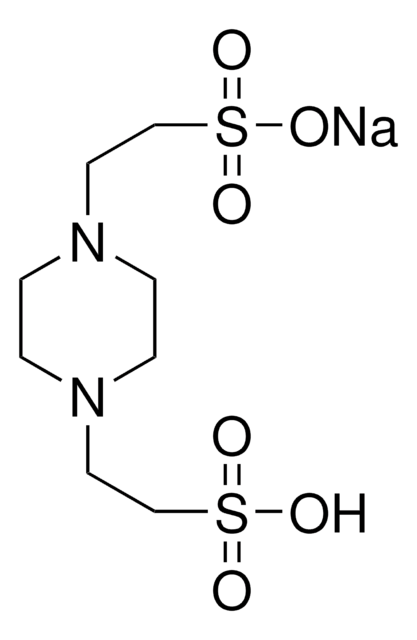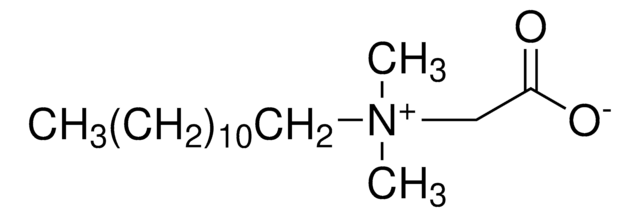P8203
PIPES
BioXtra, ≥99% (titration)
Synonym(s):
1,4-Piperazinediethanesulfonic acid, Piperazine-1,4-bis(2-ethanesulfonic acid), Piperazine-N,N′-bis(2-ethanesulfonic acid)
About This Item
Recommended Products
product line
BioXtra
Quality Level
Assay
≥99% (titration)
form
powder
impurities
Insoluble matter, passes filter test
ign. residue (900 °C)
≤0.5% (as SO4)
loss
≤0.5% loss on drying, 110°C
useful pH range
6.1-7.5
pKa (25 °C)
6.8
mp
>300 °C (lit.)
solubility
1 M NaOH: 0.5 M at 20 °C, clear, colorless
anion traces
chloride (Cl-): ≤0.2%
cation traces
Al: ≤0.005%
Ba: ≤0.0005%
Bi: ≤0.0005%
Ca: ≤0.005%
Cd: ≤0.0005%
Co: ≤0.0005%
Cr: ≤0.0005%
Cu: ≤0.0005%
Fe: ≤0.0005%
K: ≤0.005%
Li: ≤0.0005%
Mg: ≤0.0005%
Mn: ≤0.0005%
Mo: ≤0.0005%
Na: ≤0.1%
Ni: ≤0.0005%
Pb: ≤0.0005%
Sr: ≤0.0005%
Zn: ≤0.0005%
absorption
≤0.1 at 260 in 1 M NaOH at 0.5 M
≤0.1 at 280 in 1 M NaOH at 0.5 M
application(s)
diagnostic assay manufacturing
SMILES string
OS(=O)(=O)CCN1CCN(CC1)CCS(O)(=O)=O
InChI
1S/C8H18N2O6S2/c11-17(12,13)7-5-9-1-2-10(4-3-9)6-8-18(14,15)16/h1-8H2,(H,11,12,13)(H,14,15,16)
InChI key
IHPYMWDTONKSCO-UHFFFAOYSA-N
Looking for similar products? Visit Product Comparison Guide
General description
Application
PIPES has been utilized in protein crystallization., The use of PIPES in the reconstitution of dissociated tubulin
α and β subunits after their resolution on immunoadsorbent gels has been described. PIPES has been recommended for use in buffers for the in vitro study of caspases 3, 6, 7, and 8.
A published study demonstrated the usefulness of PIPES as a non-metal ion complexing buffer in such applications as protein assays. PIPES has been used in cell culture for such applications as the engineering of a thermostable mutant membrane protein in Escherichia coli.
Quality
Linkage
Preparation Note
Not finding the right product?
Try our Product Selector Tool.
Storage Class Code
13 - Non Combustible Solids
WGK
WGK 3
Flash Point(F)
Not applicable
Flash Point(C)
Not applicable
Personal Protective Equipment
Choose from one of the most recent versions:
Already Own This Product?
Find documentation for the products that you have recently purchased in the Document Library.
Customers Also Viewed
Protocols
Cell staining can be divided into four steps: cell preparation, fixation, application of antibody, and evaluation.
TE Buffer; Elution Buffer; 10x Ligation Buffer; 0.5 M PIPES Buffer; Inoue Transformation Buffer
Our team of scientists has experience in all areas of research including Life Science, Material Science, Chemical Synthesis, Chromatography, Analytical and many others.
Contact Technical Service








